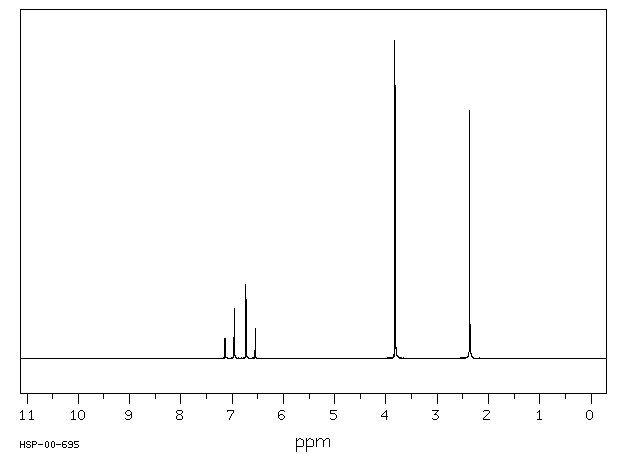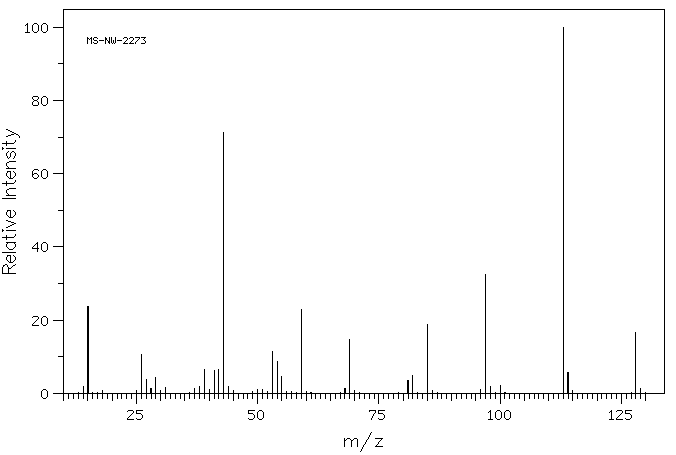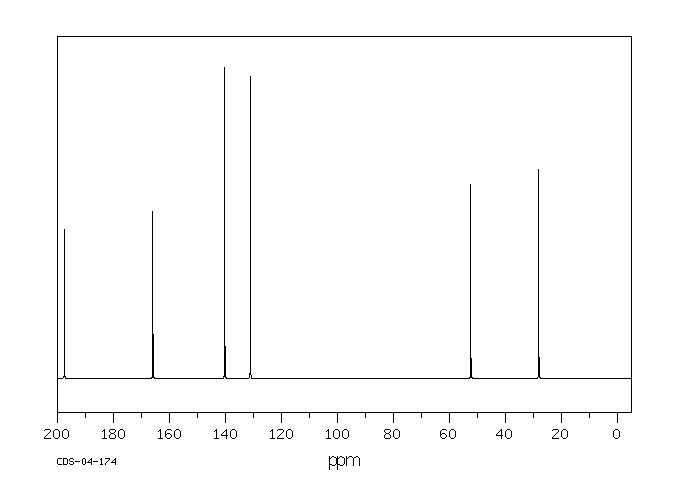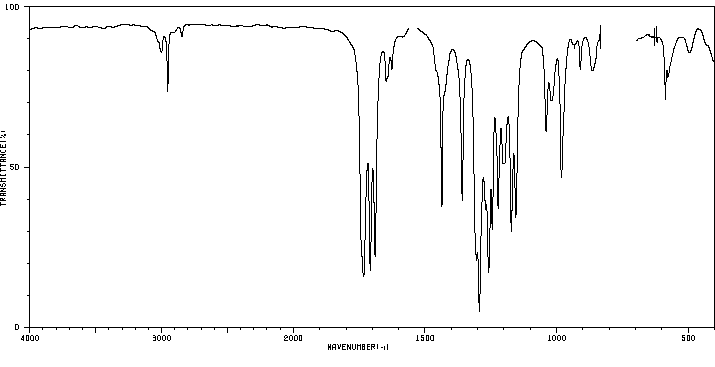反-4-氧-2-戊烯酸甲酯 | 2833-24-1
中文名称
反-4-氧-2-戊烯酸甲酯
中文别名
反-β-乙酰基丙烯酸甲酯;反-Β-乙酰基丙烯酸甲酯
英文名称
methyl (E)-4-oxo-2-pentenoate
英文别名
methyl trans-4-oxo-2-pentenoate;(E)-methyl 4-oxopent-2-enoate;methyl (E)-4-oxopent-2-enoate;(E)-methyl 4-oxopentenoate;Acetylacrylic Acid Methyl Ester
CAS
2833-24-1
化学式
C6H8O3
mdl
——
分子量
128.128
InChiKey
GLVNZYODMKSEPS-ONEGZZNKSA-N
BEILSTEIN
——
EINECS
——
-
物化性质
-
计算性质
-
ADMET
-
安全信息
-
SDS
-
制备方法与用途
-
上下游信息
-
文献信息
-
表征谱图
-
同类化合物
-
相关功能分类
-
相关结构分类
物化性质
-
熔点:59-61 °C(lit.)
-
稳定性/保质期:
如果按照规定使用和储存,则不会分解,也没有已知的危险情况发生。
计算性质
-
辛醇/水分配系数(LogP):0
-
重原子数:9
-
可旋转键数:3
-
环数:0.0
-
sp3杂化的碳原子比例:0.33
-
拓扑面积:43.4
-
氢给体数:0
-
氢受体数:3
安全信息
-
安全说明:S26,S36
-
危险类别码:R36/37/38
-
WGK Germany:3
-
储存条件:-8°C 至 2°C,应密闭保存于阴凉干燥处。
SDS
SECTION 1: Identification of the substance/mixture and of the company/undertaking
Product identifiers
Product name : Methyl trans-4-oxo-2-pentenoate
REACH No. : A registration number is not available for this substance as the substance
or its uses are exempted from registration, the annual tonnage does not
require a registration or the registration is envisaged for a later
registration deadline.
CAS-No. : 2833-24-1
Relevant identified uses of the substance or mixture and uses advised against
Identified uses : Laboratory chemicals, Manufacture of substances
SECTION 2: Hazards identification
Classification of the substance or mixture
Classification according to Regulation (EC) No 1272/2008
Skin irritation (Category 2), H315
Eye irritation (Category 2), H319
Specific target organ toxicity - single exposure (Category 3), H335
For the full text of the H-Statements mentioned in this Section, see Section 16.
Classification according to EU Directives 67/548/EEC or 1999/45/EC
Xi Irritant R36/37/38
For the full text of the R-phrases mentioned in this Section, see Section 16.
Label elements
Labelling according Regulation (EC) No 1272/2008
Pictogram
Signal word Warning
Hazard statement(s)
H315 Causes skin irritation.
H319 Causes serious eye irritation.
H335 May cause respiratory irritation.
Precautionary statement(s)
P261 Avoid breathing dust/ fume/ gas/ mist/ vapours/ spray.
P305 + P351 + P338 IF IN EYES: Rinse cautiously with water for several minutes. Remove
contact lenses, if present and easy to do. Continue rinsing.
Supplemental Hazard none
Statements
Other hazards - none
SECTION 3: Composition/information on ingredients
Substances
Chemical characterization : Natural product
: Methyl trans-β-acetylacrylate
Synonyms
Formula : C6H8O3
Molecular Weight : 128,13 g/mol
CAS-No. : 2833-24-1
Hazardous ingredients according to Regulation (EC) No 1272/2008
Component Classification Concentration
Methyl (E)-4-oxopent-2-enoate
CAS-No. 2833-24-1 Skin Irrit. 2; Eye Irrit. 2; STOT <= 100 %
SE 3; H315, H319, H335
Hazardous ingredients according to Directive 1999/45/EC
Component Classification Concentration
Methyl (E)-4-oxopent-2-enoate
CAS-No. 2833-24-1 Xi, R36/37/38 <= 100 %
For the full text of the H-Statements and R-Phrases mentioned in this Section, see Section 16
SECTION 4: First aid measures
Description of first aid measures
General advice
Consult a physician. Show this safety data sheet to the doctor in attendance.
If inhaled
If breathed in, move person into fresh air. If not breathing, give artificial respiration. Consult a physician.
In case of skin contact
Wash off with soap and plenty of water. Consult a physician.
In case of eye contact
Rinse thoroughly with plenty of water for at least 15 minutes and consult a physician.
If swallowed
Never give anything by mouth to an unconscious person. Rinse mouth with water. Consult a physician.
Most important symptoms and effects, both acute and delayed
The most important known symptoms and effects are described in the labelling (see section 2.2) and/or in
section 11
Indication of any immediate medical attention and special treatment needed
no data available
SECTION 5: Firefighting measures
Extinguishing media
Suitable extinguishing media
Use water spray, alcohol-resistant foam, dry chemical or carbon dioxide.
Special hazards arising from the substance or mixture
Carbon oxides
Advice for firefighters
Wear self contained breathing apparatus for fire fighting if necessary.
Further information
no data available
SECTION 6: Accidental release measures
Personal precautions, protective equipment and emergency procedures
Use personal protective equipment. Avoid dust formation. Avoid breathing vapours, mist or gas. Ensure
adequate ventilation. Evacuate personnel to safe areas. Avoid breathing dust.
For personal protection see section 8.
Environmental precautions
Do not let product enter drains.
Methods and materials for containment and cleaning up
Pick up and arrange disposal without creating dust. Sweep up and shovel. Keep in suitable, closed
containers for disposal.
Reference to other sections
For disposal see section 13.
SECTION 7: Handling and storage
Precautions for safe handling
Avoid contact with skin and eyes. Avoid formation of dust and aerosols.
Provide appropriate exhaust ventilation at places where dust is formed.Normal measures for preventive fire
protection.
For precautions see section 2.2.
Conditions for safe storage, including any incompatibilities
Store in cool place. Keep container tightly closed in a dry and well-ventilated place.
Recommended storage temperature: 2 - 8 °C
Specific end use(s)
A part from the uses mentioned in section 1.2 no other specific uses are stipulated
SECTION 8: Exposure controls/personal protection
Control parameters
Components with workplace control parameters
Exposure controls
Appropriate engineering controls
Handle in accordance with good industrial hygiene and safety practice. Wash hands before breaks and
at the end of workday.
Personal protective equipment
Eye/face protection
Safety glasses with side-shields conforming to EN166 Use equipment for eye protection tested
and approved under appropriate government standards such as NIOSH (US) or EN 166(EU).
Skin protection
Handle with gloves. Gloves must be inspected prior to use. Use proper glove removal technique
(without touching glove's outer surface) to avoid skin contact with this product. Dispose of
contaminated gloves after use in accordance with applicable laws and good laboratory practices.
Wash and dry hands.
The selected protective gloves have to satisfy the specifications of EU Directive 89/686/EEC and
the standard EN 374 derived from it.
Full contact
Material: Nitrile rubber
Minimum layer thickness: 0,11 mm
Break through time: 480 min
Material tested:Dermatril® (KCL 740 / Z677272, Size M)
Splash contact
Material: Nitrile rubber
Minimum layer thickness: 0,11 mm
Break through time: 480 min
Material tested:Dermatril® (KCL 740 / Z677272, Size M)
data source: KCL GmbH, D-36124 Eichenzell, phone +49 (0)6659 87300, test method: EN374
If used in solution, or mixed with other substances, and under conditions which differ from EN 374,
contact the supplier of the CE approved gloves. This recommendation is advisory only and must
be evaluated by an industrial hygienist and safety officer familiar with the specific situation of
anticipated use by our customers. It should not be construed as offering an approval for any
specific use scenario.
Body Protection
impervious clothing, The type of protective equipment must be selected according to the
concentration and amount of the dangerous substance at the specific workplace.
Respiratory protection
For nuisance exposures use type P95 (US) or type P1 (EU EN 143) particle respirator.For higher
level protection use type OV/AG/P99 (US) or type ABEK-P2 (EU EN 143) respirator cartridges.
Use respirators and components tested and approved under appropriate government standards
such as NIOSH (US) or CEN (EU).
Control of environmental exposure
Do not let product enter drains.
SECTION 9: Physical and chemical properties
Information on basic physical and chemical properties
a) Appearance Form: crystalline
Colour: light yellow
b) Odour no data available
c) Odour Threshold no data available
d) pH no data available
e) Melting point/freezing Melting point/range: 59 - 61 °C
point
f) Initial boiling point and no data available
boiling range
g) Flash point no data available
h) Evapouration rate no data available
i) Flammability (solid, gas) no data available
j) Upper/lower no data available
flammability or
explosive limits
k) Vapour pressure no data available
l) Vapour density no data available
m) Relative density no data available
n) Water solubility no data available
o) Partition coefficient: n- no data available
octanol/water
p) Auto-ignition no data available
temperature
q) Decomposition no data available
temperature
r) Viscosity no data available
s) Explosive properties no data available
t) Oxidizing properties no data available
Other safety information
no data available
SECTION 10: Stability and reactivity
Reactivity
no data available
Chemical stability
Stable under recommended storage conditions.
Possibility of hazardous reactions
no data available
Conditions to avoid
no data available
Incompatible materials
Strong oxidizing agents
Hazardous decomposition products
Other decomposition products - no data available
In the event of fire: see section 5
SECTION 11: Toxicological information
Information on toxicological effects
Acute toxicity
no data available
Skin corrosion/irritation
no data available
Serious eye damage/eye irritation
no data available
Respiratory or skin sensitisation
no data available
Germ cell mutagenicity
no data available
Carcinogenicity
IARC: No component of this product present at levels greater than or equal to 0.1% is identified as
probable, possible or confirmed human carcinogen by IARC.
Reproductive toxicity
no data available
Specific target organ toxicity - single exposure
Inhalation - May cause respiratory irritation.
Specific target organ toxicity - repeated exposure
no data available
Aspiration hazard
no data available
Additional Information
RTECS: Not available
To the best of our knowledge, the chemical, physical, and toxicological properties have not been
thoroughly investigated.
SECTION 12: Ecological information
Toxicity
no data available
Persistence and degradability
no data available
Bioaccumulative potential
no data available
Mobility in soil
no data available
Results of PBT and vPvB assessment
PBT/vPvB assessment not available as chemical safety assessment not required/not conducted
Other adverse effects
no data available
SECTION 13: Disposal considerations
Waste treatment methods
Product
Offer surplus and non-recyclable solutions to a licensed disposal company. Contact a licensed
professional waste disposal service to dispose of this material. Dissolve or mix the material with a
combustible solvent and burn in a chemical incinerator equipped with an afterburner and scrubber.
Contaminated packaging
Dispose of as unused product.
SECTION 14: Transport information
UN number
ADR/RID: - IMDG: - IATA: -
UN proper shipping name
ADR/RID: Not dangerous goods
IMDG: Not dangerous goods
IATA: Not dangerous goods
Transport hazard class(es)
ADR/RID: - IMDG: - IATA: -
Packaging group
ADR/RID: - IMDG: - IATA: -
Environmental hazards
ADR/RID: no IMDG Marine pollutant: no IATA: no
Special precautions for user
no data available
SECTION 15 - REGULATORY INFORMATION
N/A
SECTION 16 - ADDITIONAL INFORMATION
N/A
上下游信息
-
上游原料
中文名称 英文名称 CAS号 化学式 分子量 (E)-4-氧代-2-烯酸 trans-4-oxo-2-pentenoic acid 2833-28-5 C5H6O3 114.101 —— methyl (E)-4-methylpenta-2,4-dienoate 37974-16-6 C7H10O2 126.155 -
下游产品
中文名称 英文名称 CAS号 化学式 分子量 —— Methyl (Z)-4-oxo-2-pentenoate 19522-27-1 C6H8O3 128.128 (E)-4-氧代-2-烯酸 trans-4-oxo-2-pentenoic acid 2833-28-5 C5H6O3 114.101 —— methyl (E)-4-hydroxypent-2-enoate 42997-94-4 C6H10O3 130.144 —— Methyl 4-Oxo-2,7-octadienoate 108087-19-0 C9H12O3 168.192
反应信息
-
作为反应物:参考文献:名称:碘化叔丁基介导共轭Hy的还原费歇尔吲哚化摘要:已经开发出一种新型的,易于获得的N-芳基共轭与叔丁基碘化物的还原费歇尔吲哚化反应。在该反应中,叔丁基碘化物用作无水HI源,生成的HI用作布朗斯台德酸和还原剂。这种操作简单的方法允许使用各种吲哚衍生物。此外,该方法可以应用于生物活性化合物的合成。DOI:10.1002/chem.201504010
-
作为产物:参考文献:名称:新型吡咯并喹啉醌衍生物的模块化合成摘要:吡咯喹啉醌 (PQQ) 是甲醇脱氢酶和葡萄糖脱氢酶的重要辅助因子。此外,分离的 PQQ 被用作传感器和仿生复合物的核心组件。PQQ 衍生物的合成对于开发新的醇氧化催化剂和氧化还原传感器具有重要意义。这项工作描述了带有甲基和酮基团而不是羧酸部分的 PQQ 衍生物的模块化合成。这些修饰减少了 PQQ 与蛋白质环境外金属离子的可能配位点。DOI:10.1055/s-0041-1738426
文献信息
-
Kras-G12C抑制剂杂环化合物
-
Substituted 4-oxo-crotonic acid derivatives as a new class of protein kinase B (PknB) inhibitors: synthesis and SAR study作者:Changliang Xu、Xiaoguang Bai、Jian Xu、Jinfeng Ren、Yun Xing、Ziqiang Li、Juxian Wang、Jingjing Shi、Liyan Yu、Yucheng WangDOI:10.1039/c6ra24953a日期:——Protein kinase B (PknB) is an essential serine/threonine protein kinase required for Mycobacterium tuberculosis (M. tb) cell division and cell-wall biosynthesis. A high throughput screen using PknB identified a (E)-4-oxo-crotonic acid inhibitor, named YH-8, which was used as a scaffold for SAR investigations. A significant improvement in enzyme affinity was achieved. The results indicated that the
-
Nanopalladium-catalyzed conjugate reduction of Michael acceptors – application in flow作者:Anuja Nagendiran、Henrik Sörensen、Magnus J. Johansson、Cheuk-Wai Tai、Jan-E. BäckvallDOI:10.1039/c5gc02920a日期:——A continuous-flow approach towards the selective nanopalladium-catalyzed hydrogenation of the olefinic bond in various Michael acceptors, which could lead to a greener and more sustainable process, has been developed. The...已经开发出一种连续流方法,用于在各种迈克尔受体中进行选择性纳米钯催化的烯烃键的加氢反应,这可能导致更绿色和更可持续的过程。这...
-
A versatile organocatalyst for the asymmetric conjugate addition of nitroalkanes to enones作者:Claire E. T. Mitchell、Stacey E. Brenner、Steven V. LeyDOI:10.1039/b511441a日期:——5-Pyrrolidin-2-yltetrazole performs as an improved catalyst for the asymmetric addition of a range of nitroalkanes to cyclic and acyclic enones, with good to excellent enantioselectivity.
-
An efficient, asymmetric organocatalyst-mediated conjugate addition of nitroalkanes to unsaturated cyclic and acyclic ketones作者:Claire E. T. Mitchell、Stacey E. Brenner、Jorge García-Fortanet、Steven V. LeyDOI:10.1039/b601877g日期:——5-Pyrrolidin-2-yltetrazole is a versatile organocatalyst for the asymmetric conjugate addition of nitroalkanes to enones. Using this catalyst, this transformation requires short reaction times, tolerates a broad substrate scope, and possibly proceeds via generation of an iminium species.
表征谱图
-
氢谱1HNMR
-
质谱MS
-
碳谱13CNMR
-
红外IR
-
拉曼Raman
-
峰位数据
-
峰位匹配
-
表征信息
同类化合物
(±)17,18-二HETE
(±)-辛酰肉碱氯化物
(Z)-5-辛烯甲酯
(Z)-4-辛烯酸
(R)-甲羟戊酸锂盐
(R)-普鲁前列素,游离酸
(R,R)-半乳糖苷
(E)-4-庚烯酸
(E)-4-壬烯酸
(E)-4-十一烯酸
(9Z,12E)-十八烷二烯酸甲酯
(6E)-8-甲基--6-壬烯酸甲基酯-d3
(3R,6S)-rel-8-[2-(3-呋喃基)-1,3-二氧戊环-2-基]-3-羟基-2,6-二甲基-4-辛酮
龙胆二糖
黑曲霉二糖
黄质霉素
麦芽酮糖一水合物
麦芽糖醇
麦芽糖酸
麦芽糖基蔗糖
麦芽糖一水合物
麦芽糖
鳄梨油酸乙酯
鲸蜡醇蓖麻油酸酯
鲸蜡醇油酸酯
鲸蜡硬脂醇硬脂酸酯
鲸蜡烯酸脂
鲸蜡基花生醇
鲫鱼酸
鲁比前列素
鲁比前列素
高级烷基C16-18-醇
高甲羟戊酸
高效氯氰菊酯
高-gamma-亚油酸
马来酸烯丙酯
马来酸氢异丙酯
马来酸氢异丁酯
马来酸氢丙酯
马来酸氢1-[2-(2-羟基乙氧基)乙基]酯
马来酸单乙酯
马来酸单丁酯
马来酸二辛酯
马来酸二癸酯
马来酸二甲酯
马来酸二烯丙酯
马来酸二正丙酯
马来酸二戊基酯
马来酸二异壬酯
马来酸二异丙酯










